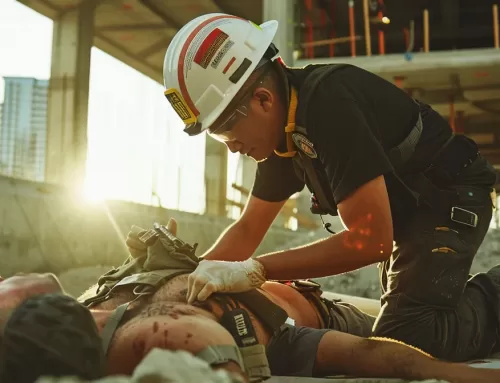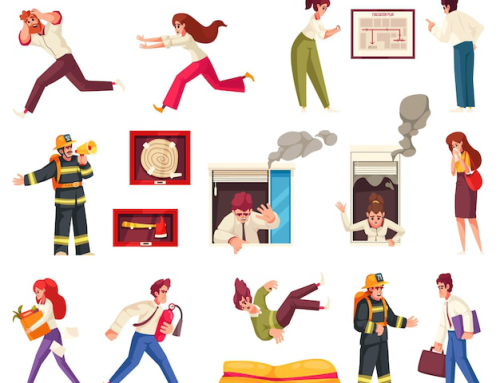Facing a fire can be a terrifying experience. Panic and adrenaline kick in, making clear thinking a challenge. But amidst the chaos, having the knowledge and skills to use a fire extinguisher can mean the difference between containing a small blaze and witnessing a disaster unfold. That’s where fire extinguisher training comes in, empowering individuals with the confidence and know-how to act swiftly and effectively in an emergency.
Here’s how fire extinguisher training can help:
Why Fire Extinguisher Training Matters
While knowing how to operate a fire extinguisher is crucial, the importance of fire extinguisher training goes far beyond remembering a simple acronym like PASS. Let’s delve deeper into the critical reasons why investing in training can truly mean the difference between controlled chaos and a full-blown disaster:
1. Early Intervention Saves Lives and Property:
- Catching a fire early:Fires grow exponentially. Even a tiny blaze left unchecked can quickly engulf a room, endangering lives and causing extensive damage. Knowing how to use an extinguisher effectively in its early stages can prevent it from spiraling out of control, potentially saving lives and protecting valuable property.
- Buying precious time for evacuation:If the fire is too large or poses an immediate danger, using an extinguisher can create a window of opportunity for safe escape. Trained individuals can assess the situation and, if necessary, use the extinguisher to create a path or hold the fire back while others evacuate safely.
2. Confidence and Preparedness in Stressful Situations
- Panic is the enemy:Facing a fire can be overwhelming, leading to panic and hindering clear thinking. Fire extinguisher training equips individuals with the knowledge and skills to act decisively in stressful situations. It instills confidence and allows them to react calmly and effectively, potentially preventing escalation and making sound decisions.
- Knowing when to fight or evacuate:Training goes beyond simply using the extinguisher. It teaches individuals to assess the fire’s size, type, and potential danger, helping them decide whether to attempt extinguishing it or prioritize evacuation. This crucial skill helps make the right choice in the heat of the moment, potentially saving lives.
3. Legal Requirements and Compliance
- Workplace safety obligations:In many workplaces, employers are legally obligated to provide fire extinguisher training to their employees. It ensures everyone understands how to use the equipment and can contribute to workplace safety.
- Residential building regulations:Some residential buildings, especially high-rises or apartments, may have regulations mandating fire extinguisher training for occupants. It ensures a basic level of fire safety awareness within the community.
4. Beyond the Basics: Building Comprehensive Understanding
- Training goes beyond PASS:While the PASS method (Pull, Aim, Squeeze, Sweep) is essential, training delves deeper into different extinguisher types, fire classes, and functionalities. It allows you to choose the correct extinguisher for the specific fire, maximizing its effectiveness and safety.
- Advanced skills and awareness:Comprehensive training programs can cover advanced skills like handling different extinguisher models and understanding fire prevention measures, evacuation procedures, and even basic first aid response. It empowers individuals to handle various fire-related situations more confidently.
Investing in Your Safety
Fire extinguisher training is not just about checking a box. It’s an investment in your safety, the safety of those around you, and potentially minimizing property damage. You are empowering yourself with knowledge, skills, and confidence to face fire emergencies effectively by taking the initiative to get trained. Remember, it’s not just about knowing how to pull a pin; it’s about understanding the bigger picture of fire safety and being prepared to act when needed.
So, make the smart choice. Seek out fire extinguisher training programs and equip yourself with the knowledge and skills that can mean a world of difference in a critical moment.
Understanding Fire Extinguisher Types and Classes
Not all fires are created equal, and neither are the extinguishers designed to combat them. Understanding the different types and classes of fire extinguishers is crucial for choosing the right weapon in the fight against flames. Here’s a detailed breakdown:
Fire Classes
Imagine fires as enemies with different weaknesses. Fire classes categorize fires based on the fuel they consume:
- Class A:Ordinary combustibles like wood, paper, fabrics, and rubber. These fires respond well to water or water-based solutions.
- Class B:Flammable liquids like gasoline, oil, paints, and alcohol. These require smothering agents like foam or carbon dioxide (CO2) to cut off oxygen supply.
- Class C:Energized electrical equipment. Water conducts electricity, making it dangerous. Special dry powder extinguishers are needed to smother the fire without harming electrical components.
- Class D:Combustible metals like magnesium, potassium, and sodium. These require specialized dry powder extinguishers designed to react with the burning metal and extinguish the fire.
- Class K:Kitchen fires involving cooking fats and oils. These require special wet chemical extinguishers that saponify (turn to soap) the burning fat, extinguishing the fire and preventing reignition.
Fire Extinguisher Types
Now, let’s discuss the weapons we have against these fiery foes:
- Water Extinguishers (Class A):These are simple and affordable, using pressurized water to cool and extinguish flames. Good for paper, wood, and fabric fires, but never use them on electrical fires or flammable liquids!
- Foam Extinguishers (Class A & B):They discharge a foamy liquid that smothers the fire and prevents reignition. Effective on Class A and B fires, making them versatile choices.
- CO2 Extinguishers (Class B & C):These discharge pressurized CO2 gas, displacing oxygen and smothering the flames. They are ideal for Class B and electrical fires but leave no residue and can be ineffective in windy conditions.
- Dry Powder Extinguishers (Class A, B, & C):These discharge a cloud of powder that coats the burning fuel, smothering the fire. They are multipurpose but can leave a messy residue and may not be suitable for delicate equipment.
- Wet Chemical Extinguishers (Class K):These are specifically designed for kitchen fires, using a wet chemical agent that saponifies burning fats and oils. They are highly effective and prevent reignition.
Choosing the Right Fire Extinguisher
Matching the fire class to the extinguisher type is paramount. Using the wrong one can be ineffective or even dangerous. Look for the fire class rating marked on the extinguisher label.
Beyond the Basics
While these are common types, remember there are specialized extinguishers for specific hazards like Class D metals or chemical fires. Always consult experts for specific needs or complex environments.
Knowledge is Power
Knowing about fire classes and extinguisher types empowers you to make informed decisions in an emergency. Invest in training, understand your extinguishers, and be prepared to fight the right fire with the right weapon. Remember, a few minutes of knowledge can make a lifetime of difference!
The PASS Method: Your Guide to Fire Extinguisher Operation
Once you have the correct extinguisher, knowing how to use it correctly is essential. Remember the PASS method:
- Pull the pin: This releases the locking mechanism, allowing you to discharge the extinguisher.
- Aim the nozzle: Point the nozzle at the base of the flames, not the tips.
- Squeeze the trigger: Discharge the agent in short bursts, aiming at the base of the fire.
- Sweep: Use a side-to-side sweeping motion to cover the entire fire area.
Remember, never use water on electrical fires or flammable liquids. It can worsen the situation and put you at risk.
Beyond the Basics: Advanced Fire Extinguisher Training
While the PASS method provides a foundation, consider seeking advanced fire extinguisher training for a deeper understanding. It could involve:
- Hands-on practice:Using training extinguishers in controlled environments to simulate real-world scenarios and build confidence.
- Understanding different extinguisher models:Learning how to operate various types of extinguishers beyond the standard ones.
- Fire safety awareness:Gaining insights into fire prevention, evacuation procedures, and first-aid response.
Investing in Your Safety: Resources for Fire Extinguisher Training
Numerous organizations offer fire extinguisher training, including:
- Local fire departments:Many fire departments offer free or subsidized training programs to residents.
- National Fire Protection Association (NFPA):The NFPA website provides resources and information on fire safety and extinguisher training.
- Private training companies:Several private companies offer comprehensive fire extinguisher training programs for individuals and businesses.
Remember,fire extinguisher training is an investment in your safety and the safety of those around you. By equipping yourself with the knowledge and skills, you can potentially turn a dangerous situation into a controlled one, potentially saving lives and minimizing damage. Take action today and empower yourself with the power of fire extinguisher training.
Some Additional Tips
- Regularly inspect and maintain your fire extinguishers according to the manufacturer’s instructions.
- Ensure fire extinguishers are easily accessible and not blocked by furniture or other objects.
- Familiarize yourself with the fire escape plan for your home or workplace.
- Practice using a fire extinguisher during training, even if it’s just a simulated model.
By following these tips and investing in fire extinguisher training, you can be prepared to face any fire emergency with confidence and knowledge, potentially making a life-changing difference.
Don’t be caught unprepared in an emergency! At Metro Safety, we offer comprehensive first-aid training programs designed to equip individuals and communities with the lifesaving skills they need.
Master essential first-aid and CPR techniques with our Level 2 First Aid Training in Surrey and our flexible Occupational First Aid Level 2 course. Explore diverse first-aid training courses in Surrey, including emergency first aid with CPR/AED Level C (offered in partnership with the Red Cross). Ensure workplace safety with our fall protection training program and related fall protection courses.
Learn crucial skills for managing confined space emergencies through our comprehensive confined space training. Empower yourself and your community! Visit our website to browse our complete range of first aid training, fall protection, and confined space training programs, including online options.










